International Journal of Information Technology and Computer Science @ijitcs
Статьи журнала - International Journal of Information Technology and Computer Science
Все статьи: 1254
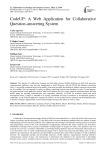
CodeUP: A Web Application for Collaborative Question-answering System
Статья научная
The majority of collaborative learning and knowledge sharing (CLKS) platforms are built with numerous communication mediums, team and task management in mind. However, with the CLKS, the Question-Answering (QAs), User profile evaluation based on the quality of answers provided, and feeding of subject or project relevant data are all available. QAs are required for online or offline cooperation between team members or users. To that purpose, this paper presents a web application called CodeUP with features like QA system, Question similarity testing, and user profile rating for boosting communication and cooperation efficiency in CLKS for academic groups and small development teams. CodeUP is intended to be quickly established and step for academic or development groups to collaborate. As the CodeUP application supports the CLKS, it is also an ideal tool for academia and development teams to perform computer supported QA system and knowledge sharing in the sphere of work or study.
Бесплатно
Статья научная
Due to the lack of particular algorithms for automatic detection and tracking of person face(s), we have developed a new algorithm to achieve detection and single/multiple face tracking in different background video sequence. To detect faces, skin sections are segmented from the frame by means of YCbCr color model; and facial features are used to agree whether these sections contain person face or not. This procedure is challenging, because face color is unique and some objects may have similar color. Further, color and Eigen features are extracted from detected faces. Based on the points detected in facial region, point tracker tracks the user specified number of faces throughout the video sequence. The developed algorithm was tested on challenging dataset videos; and measured for performance using standard metrics. Test results obtained ensure the efficiency of proposed algorithm at the end.
Бесплатно
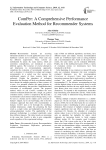
ComPer: A Comprehensive Performance Evaluation Method for Recommender Systems
Статья научная
Recommender Systems are receiving substantial attention in several application areas (such as healthcare systems and e-commerce), where each area has different requirements. These systems are multifaceted by nature. So, many metrics, which are sometimes contradictious, are introduced to assess different aspects. The existence of several alternatives and dimensions to recommendation approaches complicate the evaluation of recommender systems. In such a situation, it is desirable to evaluate and compare recommenders in a united way that assesses the multifaceted aspects of these systems fairly and uniformly. Despite the abundance of evaluation dimensions, the literature still lacks an evaluation method that evaluates the multiple properties of these systems, all at once. As a potential solution, this paper proposes an evaluation methodology that provides a multidimensional assessment of recommender systems. The proposed method, which we call ComPer, combines the most common evaluation dimensions into a single, yet, general evaluation metric. ComPer is inspired by the idea that a recommender system mimics human beings; hence, it can be seen as a human and its outputs can be assessed as human’s outputs. Up to our knowledge, this is the first evaluation approach that deals with recommenders as humans. ComPer aims to be thorough (by combining multiple dimensions), simple (by presenting the final result as a single value), and independent (by providing setting-independent results). The applicability of the proposed methodology is evaluated empirically using three different datasets. The initial results are promising in the sense that ComPer is able to give comparable results regardless of the experimental settings.
Бесплатно
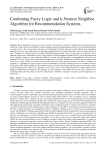
Combining Fuzzy Logic and k-Nearest Neighbor Algorithm for Recommendation Systems
Статья научная
Recommendation systems are a type of systems that are able to help users finding relevant and personalized content in a wide variety of possibilities. To help computers perform recommendations, there are several approaches used nowadays such as the Content-based approach, the Collaborative filtering approach and the Hybrid recommendation approach. However, these approaches are sometimes inappropriate for use cases where there is no prior large datasets of users’ feedbacks or ratings needed for training Machine Learning models. Thus, in this work, we proposed a novel approach based on the combination of Fuzzy Logic and the k-Nearest neighbor algorithm (KNN). The proposed approach can be applied without any prior collected feedbacks of users and performs good recommendations. Moreover, our proposal uses Fuzzy Logic to infer values based on inputs and a set of rules. Furthermore, the KNN uses the output values of the Fuzzy Logic system to do some retrieval tasks based on existing distance measures. In order to evaluate our approach, we considered an expert system of food recommendation for people suffering from the two deadliest diseases in Cameroon: HIV/AIDS and Malaria. The obtained results are closed to the recommendation made by nutritionists. These results demonstrate how effective our approach can be used to solve a real nutrition problem for people suffering from Malaria or HIV/AIDS. Furthermore, this approach can be extended to other fields and even be used to perform any recommendation task where there is no prior collected user’s feedback or ratings by using the proposed approach as a framework.
Бесплатно
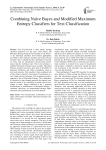
Combining Naïve Bayes and Modified Maximum Entropy Classifiers for Text Classification
Статья научная
Text Classification is done mainly through classifiers proposed over the years, Naïve Bayes and Maximum Entropy being the most popular of all. However, the individual classifiers show limited applicability according to their respective domains and scopes. Recent research works evaluated that the combination of classifiers when used for classification showed better performance than the individual ones. This work introduces a modified Maximum Entropy-based classifier. Maximum Entropy classifiers provide a great deal of flexibility for parameter definitions and follow assumptions closer to real world scenario. This classifier is then combined with a Naïve Bayes classifier. Naïve Bayes Classification is a very simple and fast technique. The assumption model is opposite to that of Maximum Entropy. The combination of classifiers is done through operators that linearly combine the results of two classifiers to predict class of documents in query. Proper validation of the 7 proposed modifications (4 modifications of Maximum Entropy, 3 combined classifiers) are demonstrated through implementation and experimenting on real life datasets.
Бесплатно
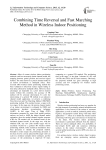
Combining Time Reversal and Fast Marching Method in Wireless Indoor Positioning
Статья научная
Most of current wireless indoor positioning methods could not accurately obtain channel model, the mapping between spatial position and received signal features. The main factor for a precise channel model in an indoor environment is multipath effect. Time reversed (TR) wireless indoor positioning method has been validated to effectively reduce signals fading or time delay affected by multipath effect. However, these advantages are depended on a prior known channel model, without this condition, the accuracy of TR method will be seriously deteriorated. To solve the shortcoming of a general TR method in an unknown channel model application, we present a combining Time Reversal and Fast Marching Method (TR-FMM) positioning method. This method locates a target with two stages. In the stage one, the precise channel model of an indoor environment is estimated by FMM and simultaneous algebraic reconstruction technique (SART). In this stage, Time of Flight (TOF) information generated by some fixed spatial position anchors are used to fulfill the indoor channel model estimation, then the needed channel impulse response (CIR) for TR method will be obtained based on the estimated channel model. In the stage two, with the obtained CIR, any new joint mobile target will be accurately located by a general TR wireless indoor positioning method. Some numerical simulations have been presented to validate the proposed method. Simulative results depict the positioning deviation is less than 3cm for a newly joined mobile target with 1cm scale in a moderate complex indoor configure, and the accuracy of the positioning is improved 30 times comparing to a general TR method. The positioning time in the stage 2 is less than 3 minutes in a PC with 1.6 GHz dual CPUs and 2G Bytes memory. Obviously, the proposed method has great advantage in high accuracy and low complexity for wireless indoor positioning system.
Бесплатно

Comparative Analysis of Data Mining Techniques for Predicting the Yield of Agricultural Crops
Статья научная
Predicting crop yields is one of the more difficult tasks in the agriculture sector. A fascinating area of research to estimate agricultural productivity has emerged from recent advancements in information technology for agriculture. Crop yield prediction is a technique for estimating crop production based on a variety of factors, including weather conditions and parameters such as temperature, rainfall, fertilizer, and pesticide use. In the world of agriculture, Data mining techniques are extremely popular. In order to predict the crop production for the following year, data mining techniques are employed and evaluated in the agricultural sector. In this paper, we carried out the comparison between Naive Bayes, K-nearest neighbor, Decision Tree, Random Forest, and K-Means clustering algorithms to predict crop yield in order to determine which method is most effective at doing so. The results show which algorithm is better suitable for this particular purpose by comparing these data mining algorithms for agricultural crop production and determining which algorithm is more successful for this outcome.
Бесплатно
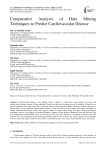
Comparative Analysis of Data Mining Techniques to Predict Cardiovascular Disease
Статья научная
Cardiovascular disease is the leading cause of death. In recent days, most people are living with cardiovascular disease because of their unhealthy lifestyle and the most alarming issue is the majority of them do not get any symptoms in the early stage. This is why this disease is becoming more deadly. However, medical science has a large amount of data regarding cardiovascular disease, so this data can be used to apply data mining techniques to predict cardiovascular disease at the early stage to reduce its deadly effect. Here, five data mining classification techniques, such as: Naïve Bayes, K-Nearest Neighbors, Support Vector Machine, Random Forest and Decision Tree were implemented in the WEKA tool to get the best accuracy rate and a dataset of 12 attributes with more than 300 instances was used to apply all the data mining techniques to get the best accuracy rate. After doing this research people who are at the early stage of cardiovascular disease or probably going to be a victim can be identified more accurately.
Бесплатно
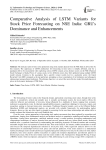
Статья научная
The intricate realm of time series prediction using stock market datasets from the NSE India is delved into by this research. The supremacy of LSTM architecture for forecasting in time series is initially affirmed, only for a paradigm shift to be encountered when exploring various LSTM variants across distinct sectors on the NSE (National Stock Exchange) of India. Prices of various stocks in five different sectors have been predicted using multiple LSTM model variants. Contrary to the assumption that a specific variant would excel in a particular sector, the Gated Recurrent Unit (GRU) emerged as the top performer, prompting a closer examination of its limitations and subsequent enhancement using technical indicators. The ultimate objective is to unveil the most effective model for predicting stock prices in the dynamic landscape of NSE India.
Бесплатно
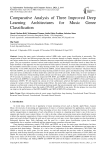
Comparative Analysis of Three Improved Deep Learning Architectures for Music Genre Classification
Статья научная
Among the many music information retrieval (MIR) tasks, music genre classification is noteworthy. The categorization of music into different groups that came to existence through a complex interplay of cultures, musicians, and various market forces to characterize similarities between compositions and organize collections is known as a music genre. The past researchers extracted various hand-crafted features and developed classifiers based on them. But the major drawback of this approach was the requirement of field expertise. However, in recent times researchers, because of the remarkable classification accuracy of deep learning models, have used similar models for MIR tasks. Convolutional Neural Net- work (CNN), Recurrent Neural Network (RNN), and the hybrid model, Convolutional - Recurrent Neural Network (CRNN), are such prominently used deep learning models for music genre classification along with other MIR tasks and various architectures of these models have achieved state-of-the-art results. In this study, we review and discuss three such architectures of deep learning models, already used for music genre classification of music tracks of length of 29-30 seconds. In particular, we analyze improved CNN, RNN, and CRNN architectures named Bottom-up Broadcast Neural Network (BBNN) [1], Independent Recurrent Neural Network (IndRNN) [2] and CRNN in Time and Frequency dimensions (CRNN- TF) [3] respectively, almost all of the architectures achieved the highest classification accuracy among the variants of their base deep learning model. Hence, this study holds a comparative analysis of the three most impressive architectural variants of the main deep learning models that are prominently used to classify music genre and presents the three architecture, hence the models (CNN, RNN, and CRNN) in one study. We also propose two ways that can improve the performances of the RNN (IndRNN) and CRNN (CRNN-TF) architectures.
Бесплатно
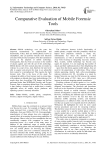
Comparative Evaluation of Mobile Forensic Tools
Статья научная
Mobile technology, over the years, has improved tremendously in sophistication and functionality. Today, there are mobile phones, known as smartphones, that can perform virtually most functions associated with personal computers. This has translated to increase in the adoption of mobile technology. Consequently, there has been an increase in the number of attacks against and with the aid of this technology. Mobile phones will often contain data that are needed as evidence in a court of law. And, therefore, the need to be able to acquire and present this data in an admissible form cannot be overemphasized. This requires the right forensic tools. This is the focus of this study. We evaluated the ability of four forensic tools to extract data, with emphasis on deleted data, from Android phones. Our results show that AccessData FTK Imager and EnCase performed better than MOBILedit Forensic and Oxygen Forensic Suite at acquiring deleted data. The conclusion is that, finding a forensic tool or toolkit that is virtually applicable across all mobile device platforms and operating systems is currently infeasible.
Бесплатно
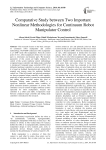
Статья научная
This research focuses on the basic concepts of continuum robot manipulator and control methodology. OCTARM Continuum robot manipulator is a 6 DOF serial robot manipulator. From the control point of view, robot manipulator divides into two main parts i.e. kinematics and dynamic parts. The dynamic parameters of this system are highly nonlinear. To control of this system nonlinear control methodology (computed torque controller and sliding mode controller) is introduced. Computed torque controller (CTC) is an influential nonlinear controller to certain systems which it is based on feedback linearization and computes the required arm torques using the nonlinear feedback control law. When all dynamic and physical parameters are known computed torque controller works superbly; practically a large amount of systems have uncertainties and sliding mode controller reduce this kind of limitation. Sliding mode controller (SMC) is a significant nonlinear controller under condition of partly uncertain dynamic parameters of system. This controller is used to control of highly nonlinear systems especially for robot manipulators, because this controller is a robust and stable. Comparative study between computed torque controller and sliding mode controller is introduced in this research.
Бесплатно
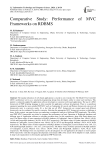
Comparative Study: Performance of MVC Frameworks on RDBMS
Статья научная
The regular utilization of web-based applications is crucial in our everyday life. The Model View Controller (MVC) architecture serves as a structured programming design that developers utilize to create user interfaces. This pattern is commonly applied by application software developers to construct web-based applications. The use of a MVC framework of PHP Scripting language is often essential for application software development. There is a significant argument regarding the most suitable PHP MVC such as Codeigniter & Laravel and Phalcon frameworks since not all frameworks cater to everyone's needs. It's a fact that not all MVC frameworks are created equal and different frameworks can be combined for specific scenarios. Selecting the appropriate MVC framework can pose a challenge at times. In this context, our paper focuses on conducting a comparative analysis of different PHP frameworks. The widely used PHP MVC frameworks are picked to compare the performance on basic Operation of Relational databases and different type of Application software to calculate execution time. In this experiment a large (Big Data) dataset was used. The Mean values of insert operation in MySQL database of Codeigniter, Laravel, Phalcon were 149.64, 149.99, 145.48 and PostgreSQL database`s 48.259, 49.39, 45.87 respectively. The Mean values of Update operation in MySQL database of Codeigniter, Laravel, Phalcon were 149.64, 158.39, 207.82 and PostgreSQL database`s 48.24, 49.39, 46.64 respectively. The Mean values of Select operation in MySQL database of Codeigniter, Laravel, Phalcon were 1.60, 3.23, 0.98 and PostgreSQL database`s 1.95, 4.57, 2.36 respectively. The Mean values of Delete operation in MySQL database of Codeigniter, Laravel, Phalcon were 150.27, 156.99, 149.63 and PostgreSQL database`s 42.95, 48.25, 42.07 respectively. The findings from our experiment can be advantageous for web application developers to choose proper MVC frameworks with their integrated development environment (IDE). This result will be helpful for small, medium & large-scale organization in choosing the appropriate PHP Framework.
Бесплатно
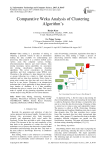
Comparative Weka Analysis of Clustering Algorithm's
Статья научная
Data mining is a procedure of mining or obtaining a pertinent volume of data or information making the data available for understanding and processing. Data analysis is a common method across various areas like computer science, biology, telecommunication industry and retail industry. Data mining encompass various algorithms viz. association rule mining, classification algorithm, clustering algorithms. This survey concentrates on clustering algorithms and their comparison using WEKA tool. Clustering is the splitting of a large dataset into clusters or groups following two criteria ie. High intra-class similarity and low inter-class similarity. Every cluster or group must contain one data item and every data item must be in one cluster. Clustering is an unsupervised technique that is fairly applicable on large datasets with a large number of attributes. It is a data modelling technique that gives a concise view of data. This survey tends to explain all the clustering algorithms and their variant analysis using WEKA tool on various datasets.
Бесплатно
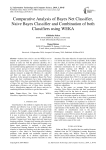
Статья научная
Authors here tried to use the WEKA tool to evaluate the performance of various classifiers on a dataset to come out with the optimum classifier, for a particular application. A Classifier is an important part of any machine learning application. It is required to classify various classes and get to know whether the predicted class lies in the true class. There are various performance analysis measures to judge the efficiency of a classifier and there are many tools which provide oodles of classifiers. In the present investigation, Bayes Net, Naive Bayes and their combination have been implemented using WEKA. It has been concluded that the combination of Bayes Net and Naive Bayes provides the maximum classification efficiency out of these three classifiers. Such a hybridization approach will always motivate for combining different classifiers to get the best results.
Бесплатно
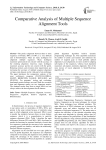
Comparative analysis of multiple sequence alignment tools
Статья научная
The perfect alignment between three or more sequences of Protein, RNA or DNA is a very difficult task in bioinformatics. There are many techniques for alignment multiple sequences. Many techniques maximize speed and do not concern with the accuracy of the resulting alignment. Likewise, many techniques maximize accuracy and do not concern with the speed. Reducing memory and execution time requirements and increasing the accuracy of multiple sequence alignment on large-scale datasets are the vital goal of any technique. The paper introduces the comparative analysis of the most well-known programs (CLUSTAL-OMEGA, MAFFT, BROBCONS, KALIGN, RETALIGN, and MUSCLE). For programs’ testing and evaluating, benchmark protein datasets are used. Both the execution time and alignment quality are two important metrics. The obtained results show that no single MSA tool can always achieve the best alignment for all datasets.
Бесплатно
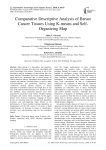
Comparative descriptive analysis of breast cancer tissues using k-means and self-organizing map
Статья научная
Data mining is a descriptive and predictive data analytical technique that discovers meaningful and useful knowledge from dataset. Clustering is one of the descriptive analytic techniques of data mining that uses latent statistical information that exists among dataset to group them into meaningful and or useful groups. In clinical decision making, information from medical tests coupled with patients’ medical history is used to make recommendations, and predictions. However, these voluminous medical datasets analysis is always dependent of individual analyzer that might have in one way or the other introduced human error. In other to solve this problem, many automated analyses have been proposed by researchers using various machine learning techniques and various forms of dataset. In this paper, dataset from electrical impedance imaging of breast tissues are clustered using two unsupervised algorithms (k-means and self-organizing map). Result of the performances of these machine learning algorithms as implemented with R i368 version 3.4.2 shows a slight outperformance of K-means in terms of classification accuracy over self-organizing map for the considered dataset.
Бесплатно
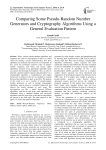
Статья научная
Since various pseudo-random algorithms and sequences are used for cryptography of data or as initial values for starting a secure communication, how these algorithms are analyzed and selected is very important. In fact, given the growingly extensive types of pseudo-random sequences and block and stream cipher algorithms, selection of an appropriate algorithm needs an accurate and thorough investigation. Also, in order to generate a pseudo-random sequence and generalize it to a cryptographer algorithm, a comprehensive and regular framework is needed, so that we are enabled to evaluate the presented algorithm as quick as possible. The purpose of this study is to use a number of pseudo-random number generators as well as popular cryptography algorithms, analyze them in a standard framework and observe the results obtained in each stage. The investigations are like a match between different algorithms, such that in each stage, weak algorithms are eliminated using a standard method and successful algorithms enter the next stage so that the best algorithms are chosen in the final stage. The main purpose of this paper is to certify the approved algorithm.
Бесплатно

Comparing the Performances of Ensemble-classifiers to Detect Eye State
Статья научная
Brain signals required for the brain-computer interface are obtained through the electroencephalography (EEG) method. EEG data is used in the analysis of many problems such as epileptic seizure detection, bipolar mood disorder, attention deficit, and detection of the sleep state of the vehicle driver. It is very important to determine whether the eye is open or closed, which is a substantial organ for the determination of the cognitive state of the person. The aim of this paper is to present a stable and successful model for detecting the eye states that are opened or closed. In this context, the performances of several ensemble classifiers were examined on the Emotiv EEG Neuroheadset dataset, which has 14 features excluding the target variable, 14980 records that have 8225 eye states opened and 6755 eye states closed. In the experiments, firstly the min-max normalization process was applied to the dataset, and then the classification performances of these classifiers were evaluated via a 5-fold cross-validation technique. The performance of each model was measured using accuracy, sensitivity, and specificity metrics. The obtained results show that the Random Forest algorithm is an acceptable level with 92.61% value of accuracy, 94.31% value of sensitivity and 91.36% value of specificity for detecting the eye state.
Бесплатно
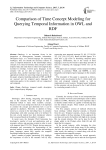
Comparison of Time Concept Modeling for Querying Temporal Information in OWL and RDF
Статья научная
Ontology is an important factor in the integration of heterogeneous semantic information. Description logic, as a formal language for expressing ontologies, does not include the necessary features to create a temporal dimension in the relationships among concepts. It is critical to introduce time concepts to model temporal data and relate them to other non-temporal data recorded in ontology. Current query languages in the semantic web are not able to respond to temporal questions; thus, another important issue is to have the appropriate methods for answering temporal questions. In this paper, temporal modeling methods in OWL and RDF are assessed and the temporal query languages for expressing queries in the semantic web are categorized and compared.
Бесплатно

